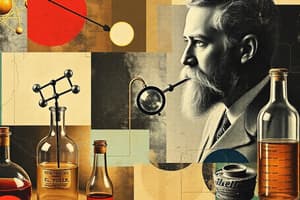Podcast
Questions and Answers
Which of the following statements aligns with Dalton's Atomic Theory?
Which of the following statements aligns with Dalton's Atomic Theory?
- Atoms of different elements can have identical masses.
- All atoms are made up of protons and neutrons.
- Electrons are held in fixed orbits around the nucleus.
- Atoms combine in fixed ratios to form compounds. (correct)
What was a significant contribution of Rutherford's discovery?
What was a significant contribution of Rutherford's discovery?
- He proposed that electrons are evenly distributed in the atom.
- He discovered the neutron, giving insight into atomic mass.
- He determined the nucleus contains most of the atom's mass. (correct)
- He introduced the concept of atomic orbitals based on probability.
Which statement best describes the evolution of atomic models from Dalton to Schrödinger?
Which statement best describes the evolution of atomic models from Dalton to Schrödinger?
- All models maintained the idea of fixed electron orbits around the nucleus.
- Atoms were initially considered indivisible but later defined by electron clouds.
- The concept of electrons was discarded in favor of protons and neutrons.
- The understanding of atomic structure progressed from simplistic to complex representations. (correct)
Which of the following discoveries directly challenged Dalton's notion of indivisible atoms?
Which of the following discoveries directly challenged Dalton's notion of indivisible atoms?
What concept did Bohr introduce that refined previous atomic models?
What concept did Bohr introduce that refined previous atomic models?
Flashcards are hidden until you start studying
Study Notes
Dalton’s Atomic Theory
- Proposed by John Dalton in 1807
- Atoms are the smallest unit of matter, and they are indivisible.
- Atoms of the same element are identical in mass and properties.
- Atoms of different elements have different masses and properties.
- Atoms combine in simple whole number ratios to form compounds.
Later Changes to Dalton’s Theory
- 1897: J.J. Thomson discovered the electron, a negatively charged particle within the atom.
- 1909: Ernest Rutherford proposed the nuclear model of the atom. He discovered that the atom consists of a small, dense, positively charged nucleus surrounded by negatively charged electrons.
- 1913: Niels Bohr proposed that electrons occupy specific energy levels. Electrons can move between these levels by absorbing or emitting energy.
- 1932: James Chadwick discovered the neutron, a neutral particle located in the nucleus.
- 1926 onwards: Schrödinger, Born, and Heisenberg developed the theory of quantum mechanics, which describes the probability of finding an electron in a specific location around the nucleus, rather than a fixed orbit.
Studying That Suits You
Use AI to generate personalized quizzes and flashcards to suit your learning preferences.




